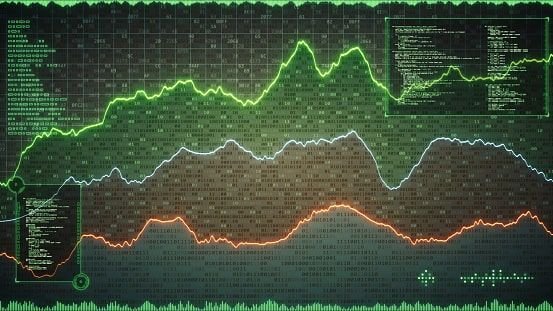Technical analysis is a methodology for analysing financial assets to forecast future price movements based on past market data. Technical analysts believe that by studying patterns in historical pricing, one can identify trends and make educated guesses about where the asset’s value might be headed in the future.
Price patterns are essential for technical analysts, as they can provide clues to potential future price moves. These patterns typically occur when prices reach certain levels or behave in specific ways over time. Charting is often used to recognise these patterns, as chartists look for shapes like triangles, wedges, flags, and head-and-shoulders formations to forecast upcoming price changes.
The triangle
One common type of chart pattern is the triangle, formed when two trendlines converge. These trendlines are created as the asset’s prices move in a zigzag pattern and stop approaching each other at various levels. Depending on the direction of the breakout, triangles can be seen as bullish (converging upwards) or bearish (converging downwards). The general rule is that a break above the upper line indicates an impending uptrend, while a break below the lower line signals a potential downtrend.
The head-and-shoulders pattern
The head-and-shoulders pattern is another famous price formation and occurs when there are three peaks in a chart: one prominent peak (the head) followed by two smaller ones (the shoulders). This setup is typically viewed as a bearish signal, as the break of the support line at the neckline indicates that prices could be headed lower.
Conversely, a reverse head-and-shoulders pattern is seen as a bullish signal and typically forms when there are three troughs in a chart: one large trough (the head) followed by two smaller ones (the shoulders).
The flag formation
The flag formation is another technical indicator used to forecast future price movements. This pattern consists of two parallel trendlines forming a chart’s rectangle shape. The upper line acts as resistance, and the lower line acts as support. If prices break out from either side of this setup, it could signal an upcoming trend in the same direction.
Wedges
Finally, wedges are triangular formations on charts where two trendlines converge towards each other. Unlike triangles, wedges usually indicate a continuation of the current trend, either upwards (bullish wedge) or downwards (bearish wedge).
The risks of using price pattern analysis in stock trading
Price pattern analysis can provide valuable insights into the direction of a financial asset’s future price movements. Still, it is essential to note that these patterns are not foolproof and come with certain risks. For example, false signals may occur if support or resistance levels are broken too soon or too late. Additionally, these patterns can be highly subjective and open to misinterpretation. A chartist’s analysis may differ from another trader’s interpretation of the same data.
The risk of any trading strategy also increases when applied to illiquid securities or assets with low trading volume. These market conditions can make it difficult for traders to accurately determine a security’s underlying value using any technical analysis, including price pattern analysis. Furthermore, such markets may experience greater volatility, making it even more challenging for traders to forecast future prices and generate profits from trading stocks.
As with all forms of technical analysis, price pattern analysis should also be used in conjunction with other fundamental techniques and strategies, such as trend following and momentum trading. When relying solely on one form of analysis, traders could miss out on potential opportunities or enter into unfavourable trades due to false signals generated by the model.
Conclusion
Price patterns are an essential tool in technical analysis and can provide hints as to where prices could be headed in the future. By studying charts and looking for common formations like triangles, head-and-shoulders patterns, flags, and wedges, traders can better predict upcoming trends and make smarter trading decisions. However, as with any market forecasting, it is essential to remember that past performance does not guarantee future success.
Professional guidance should always be sought when making investment decisions. Learning about price patterns is just one part of becoming a successful trader. Other essential factors to consider are asset selection, risk management, and having a well-crafted strategy. With the right combination of knowledge and effort, traders can make more informed decisions with their trading activities.




